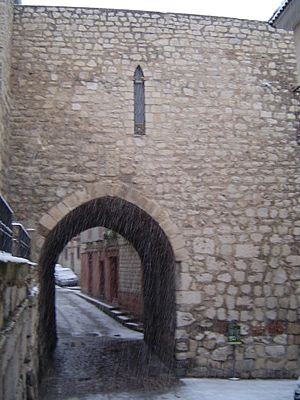Arc of San Lorenzo facts for kids
Quick facts for kids Arc of San Lorenzo |
|
|---|---|
| Native name Spanish: Arco de San Lorenzo |
|
 |
|
| Location | Jaén, Spain |
| Official name: Arco de San Lorenzo | |
| Type | Non-movable |
| Criteria | Monument |
| Designated | 1877 |
| Reference no. | RI-51-0000021 |
| Lua error in Module:Location_map at line 420: attempt to index field 'wikibase' (a nil value). | |
The Arc of San Lorenzo (in Spanish, Arco de San Lorenzo) is a very old and special arch in the city of Jaén, Spain. You can find it where Almendros Aguilar and Madre de Dios streets meet. This arch is actually a remaining part of the old Church of San Lorenzo, which was built a long, long time ago, between the 13th and 14th centuries.
Inside the arch, you can still see beautiful Moorish tiles and wooden panels. There's also a small chapel. Today, an association called Amigos de San Antón ('Friends of Saint Anthony') uses the space. Because it's so important, the arch was officially recognized as a Bien de Interés Cultural (a site of cultural interest) in 1877.
Contents
A Look Back: History of the Arch
The Arc of San Lorenzo has seen many important events over the centuries.
Royal Connections
People say that the wake for King Fernando IV, also known as "The Summoned," was held here. He passed away in Jaén on September 17, 1312. Because of this, for hundreds of years, special prayers for the dead were said at the arch during funerals for the city's bishops.
Another important person, Maximiliano of Austria, was baptized here on July 6, 1555. He was the uncle of King Carlos I of Spain.
A Place of Rest and Healing
Juan de Olid, who was a secretary to a famous leader named Miguel Lucas de Iranzo, is buried inside the arch.
The small chapel within the arch used to be part of the Hospital de la Madre de Dios ('Mother of God Hospital'). This hospital was started in a nearby house in 1491 by Don Luis de Torres. The chapel also served as the very first chapel for the Seminario Conciliar de Jaén ('Jaén Theological Seminary'), which was founded in 1620.
Saving the Arch
Sadly, in 1825, the main Church of San Lorenzo fell apart because it wasn't taken care of. Only the arch remained standing. The church's parish (its local community) and its old records were moved to the Church of Saint Bartholomew. The church's valuable art was divided between the Church of Saint Bartholomew and the Church of La Merced.
In 1877, the Arc of San Lorenzo was declared a national monument. This happened thanks to a group of people from Jaén who worked hard to stop it from being completely torn down.
Later, in 1969, a government department called the Dirección General de Bellas Artes started a project to restore the arch. A local architect from Jaén, Luis Berges Roldán, led this important work.
The Chapel Inside
The chapel inside the arch has a special ceiling made of brick arches. In the middle, a decorative lamp hangs from a plaster decoration. The walls of the chapel are covered with beautiful Moorish tiles.
At the altar, there is a small arched space with a crucifix (a cross with Jesus) against a red background. This space is decorated with fancy Moorish plasterwork that frames the tile panels. On both sides of the entrance, you can see an old Gothic inscription that says: "This Chapel of Jesus of Nazareth is ... from the Mother of God Hospital" (in Spanish: Esta capilla de Jesús Nazareno es ... del Hospital de la Madre de Dios).
See also
 In Spanish: Arco de San Lorenzo para niños
In Spanish: Arco de San Lorenzo para niños
- List of Bien de Interés Cultural in the Province of Jaén (Spain)

